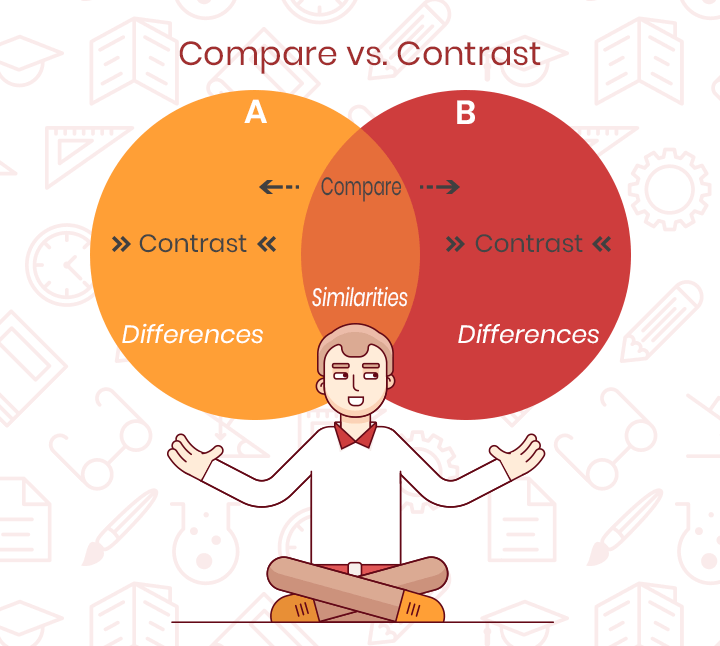Comparing and contrasting arguments are important techniques in critical reading that help readers analyze, evaluate, and understand the various perspectives contained in the text. In the critical reading process, the ability to compare and contrast arguments allows readers to see issues holistically, identify biases, and draw better conclusions. The following is a detailed explanation of the importance of this technique:
- Identify Similarities and Differences
Comparing and contrasting arguments helps readers to recognize the similarities and differences between various points of view. By seeing where arguments support each other, readers can understand certain consistencies or patterns in the topics discussed. On the other hand, differences in arguments can reveal the complexity of the issue and lead readers to explore the reasons behind the differences.
For example, if one reads two articles about education policy, one that supports a national curriculum and another that emphasizes the importance of regional autonomy, the reader can understand that there is a conflict between national standards and local needs. This identification allows the reader to dig deeper into possible solutions.
2. Develope Critical Thinking
Critical thinking is the essence of critical reading. By comparing and contrasting arguments, readers are encouraged to think more deeply, evaluate the claims made, and question the logic used. This technique helps readers not to receive information passively, but rather to analyze whether the argument is valid and supported by strong evidence.For example, if one argument uses statistical data to support a claim, while another argument relies solely on opinion, readers may judge that the data-supported argument is stronger. This helps in choosing which argument is more credible.
3. Identifying Biases and Assumptions
Every argument has an underlying bias or assumption. By comparing two or more arguments, readers can recognize these biases and evaluate how they influence the author’s point of view.
For example, an article written by an economist may emphasize the importance of economic growth without considering social impacts, while another article written by a social activist may focus more on social justice. By recognizing these biases, readers can understand that a particular perspective is often influenced by the author’s background and goals.
4. Improve Context Understanding
In critical reading, context is very important. Comparing arguments helps readers understand how the same issue can be viewed from different points of view, depending on the cultural, social, or economic context. This technique helps readers to connect the information obtained with a broader context, so that their understanding becomes more comprehensive.
For example, in reading arguments about climate change, articles from developed countries might emphasize the responsibility of developing countries in reducing carbon emissions, while articles from developing countries might highlight the historical responsibility of developed countries in global pollution. By comparing these two arguments, readers can understand that this issue has complex global dimensions.
5. Sharpen your ability to make conclusions
Comparing and contrasting arguments allows readers to draw more informed conclusions. By evaluating various points of view, readers can form opinions that are based on evidence and not just assumptions. This technique also helps in identifying possible solutions to the problem under discussion.For example, if one article suggests a technological solution to the problem of water scarcity and another article emphasizes the importance of conservation policies, readers may conclude that an effective solution may require a combination of both approaches.
6. Improve Analytical Skills
Comparing and contrasting arguments involves analyzing important elements such as main claims, supporting evidence, logic, and argument structure. This technique helps readers hone their analytical skills, so they are better able to evaluate texts objectively. For example, readers can evaluate whether the evidence used is relevant and strong enough to support the claim. If an article uses outdated data, while another article presents the most recent data, readers may conclude that the article with the most recent data is more reliable.
Practical Example: Comparing Arguments in Climate Change To understand the importance of this technique, imagine the reader is analyzing two articles about climate change. The first article argues that the main solution is through government policies such as reducing fossil fuel subsidies.
The second article highlights the role of individuals in adopting environmentally friendly lifestyles, such as reducing plastic use.By comparing these two arguments, readers can see that solutions to climate change require a combination of top-down (government policy) and bottom-up (individual action) approaches. This approach allows for a more balanced and in-depth understanding of the problem.
7. Encourage Reflective Thinking
Comparing and contrasting arguments also encourages readers to reflect on their own positions on the issues discussed. By evaluating multiple perspectives, readers can reconsider their beliefs or assumptions and open themselves to different views.
Conclusion
The technique of comparing and contrasting arguments plays an important role in critical reading because it helps readers become more critical, reflective, and sensitive to various points of view. By using this technique, readers not only improve their reading abilities, but also develop critical thinking skills that are very useful in everyday life. Readers become better able to evaluate information, make decisions based on evidence, and understand the complexity of the issues at hand. In today’s information-saturated world, this ability is invaluable.

